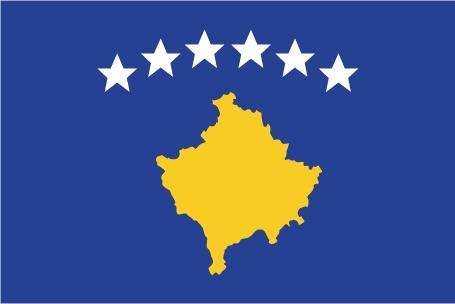86 Kosovo

Centered on a dark blue field is a gold-colored silhouette of Kosovo surmounted by six white, five-pointed stars arrayed in a slight arc. Each star represents one of the major ethnic groups of Kosovo: Albanians, Serbs, Turks, Gorani, Roma, and Bosniaks.
Flag courtesy of CIA World Factbook

Map courtesy of the CIA World Factbook

Goddess on the Throne is one of the most significant archaeological artifacts of Kosovo and has been adopted as the symbol of Pristina.
Kosovo declared independence from Serbia on February 17, 2008, but has not gained complete international recognition to allow it to become a member of the UN. By some, Kosovo is seen as capable of independence, though it technically still remains part of Serbia, acting as an independent province. However, Kosovo is not listed as an official non-member state of the UN, though it has joined the International Monetary Fund and the World Bank, which are two other international communities focused more on international economy and global trade rather than geopolitical issues.
Last updated on October 27, 2025
Government
According to Britannica, in 1971 amendments to the Yugoslav constitution granted Serbia’s two autonomous provinces, Kosovo and Vojvodina, nearly equal status with the six republics of Yugoslavia. In 1974 a new Yugoslav constitution enshrined the provinces’ equal status and gave them the right to issue their own constitutions. However, following the rise to power of Slobodan Milošević (president of Serbia from 1989), the government in Belgrade revoked the provinces’ autonomy and retook political control. Kosovo thus was administered by Serbia until the conflict of 1998–99, after which Serbian and Yugoslav forces withdrew and the UN oversaw the installment of an interim administration. Under the guidance of the UN mission, Kosovar Albanians established central and municipal government institutions, while the UN worked to resolve Kosovo’s future status. Multilateral talks on the subject led to a plan, developed by UN special envoy Martti Ahtisaari and supported by Kosovar Albanians, whereby Kosovo would eventually gain independence. But because Serbia strongly opposed the idea of Kosovar independence, Russia blocked UN approval of the Ahtisaari Plan in 2007. Further talks failed to produce any agreement, and on Feb. 17, 2008, Kosovo unilaterally declared its independence. That April a Kosovar assembly approved a constitution, which took effect on June 15, 2008. Although the constitution granted local self-government to Kosovo’s Serb communities and offered special protection for Serb cultural and religious sites, many Serbs rejected both the declaration of independence and the new government. Numerous Serbs boycotted subsequent elections, preferring to support the parallel administrative structures organized by Serb groups and backed by Belgrade, structures that the Kosovar government deemed illegal. According to the 2008 constitution, the executive branch of government is led by a president (head of state) and a prime minister (head of government). The president is elected by the Assembly of Kosovo for a five-year term, with the right to be reelected to one additional term. The president appoints the prime minister upon a recommendation by the majority party or coalition in the Assembly. The Assembly is a unicameral legislature composed of 120 deputies directly elected by voters for four-year terms. Of the 120 seats in the Assembly, 100 are distributed on the basis of proportional representation, at least 10 are guaranteed for Kosovar Serbs, and 10 are reserved for members of the Bosniak (Bosnian Muslim), Turkish, Roma, Ashkali, Egyptian, and Gorani communities.
Municipalities are the basic units of local government. Each municipality is administered by a mayor and a municipal assembly, elected every four years by proportional representation. Municipalities have the right to associate with each other and to participate in the selection of local police commanders. Some municipalities with predominantly Serb populations have special rights, such as the operation of a secondary health system, oversight of postsecondary education, and management of cultural and religious sites.
The Supreme Court of Kosovo is the highest judicial authority for all matters except constitutional questions, which are decided by the Constitutional Court. For the Supreme Court and lower courts of appeal, at least 15 percent of the judges must hail from minority communities. An independent judicial council ensures the impartiality of the judicial system. The judicial council also recommends candidates for the judiciary to the president of Kosovo, who makes the appointments.
Civil Aviation Authority of the Republic of Kosovo (CAAK)
Civil Aviation Authority of the Republic of Kosovo (CAAK) was established under Law No. 03/L-051 on Civil Aviation as an independent civil aviation regulatory agency. CAAK is responsible for the regulation of civil aviation safety and the economic regulation of airports and air navigation services in the Republic of Kosovo. Civil Aviation activities in Kosovo air space are carried out in accordance with the provisions of the Law on Civil Aviation, the Convention on International Civil Aviation of 7 December 1944, and the Agreement on the Establishment of a European Common Aviation Area. Kosovo has the appropriate legislative framework for aviation and the oversight of aviation activities. Regulations and requirements are constantly being developed to align Kosovo’s aviation legislation and procedures with international requirements such as the Standards and Recommended Practices of the International Civil Aviation Organization and, particularly with EU aviation acquis as part of our obligations under European Common Aviation Agreement, to which Kosovo is a party. Policies and guidance materials both for the industry and for CAAK staff are developed for enabling ease of understanding and compliance with the regulations and standards. The cornerstone of aviation safety operations is the implementation of Safety Management Systems by all operators from aerodromes to airlines to providers of air traffic services and maintenance organizations. CAAK is committed to achieving the highest possible safety level in Kosovo. CAAK has enforcement mandate for achieving compliance with the regulations and standards.
Airspace
SkyVector – Google Maps – ADS-B Exchange
ICAO countries publish an Aeronautical Information Publication (AIP). This document is divided into three parts: General (GEN), En Route (ENR) and Aerodromes (AD). ENR 1.4 details the types of airspace classes they chose to adopt from classes A through G.
Drone Regulations
Advanced Air Mobility (AAM) Regulations & Policies
None found by the author.
However, should you, the reader, happen to stumble across something to the contrary, please email the author at FISHE5CA@erau.edu and you may be mentioned in the ACKNOWLEDGEMENTS section of this book by way of thanks for contributing to this free eBook!
Advanced Air Mobility (AAM) News
None found by the author.
However, should you, the reader, happen to stumble across something to the contrary, please email the author at FISHE5CA@erau.edu and you may be mentioned in the ACKNOWLEDGEMENTS section of this book by way of thanks for contributing to this free eBook!
Short Essay Questions
Scenario-Based Question
You have been hired by a Drone Startup Company. Your boss has immediately assigned this job to you.
They need you to prepare a one-page memo detailing the legalities of using a drone to film in Kosovo.
They need you to mention any national laws and local ordinances.
They specifically want to know what airspace (insert pictures) you will be operating in and whether or not you need an airspace authorization.
Does it matter whether or not you are a citizen of the country?
Lastly, there is a bonus for you if, as you scroll through this chapter, you find any typos or broken links!
Short Essay Questions
- What are the drone categories?
- How is registration addressed?
- How is remote ID addressed?
- What are the model aircraft rules?
- What are the commercial drone rules?
- Are there waivers or exemptions to the rules? If so, for what?
- Would you share a link to an interactive airspace map?
- How is BVLOS addressed?
- How can you fly drones at night?
- How can you fly drones over people?
- Where do you find drone NOTAMs?
- What are the rules for drone maintenance?
- What are the rules for an SMS program?
- What are some unique rules not mentioned above?
- What are the C-UAS rules?
- What are the AAM rules?

